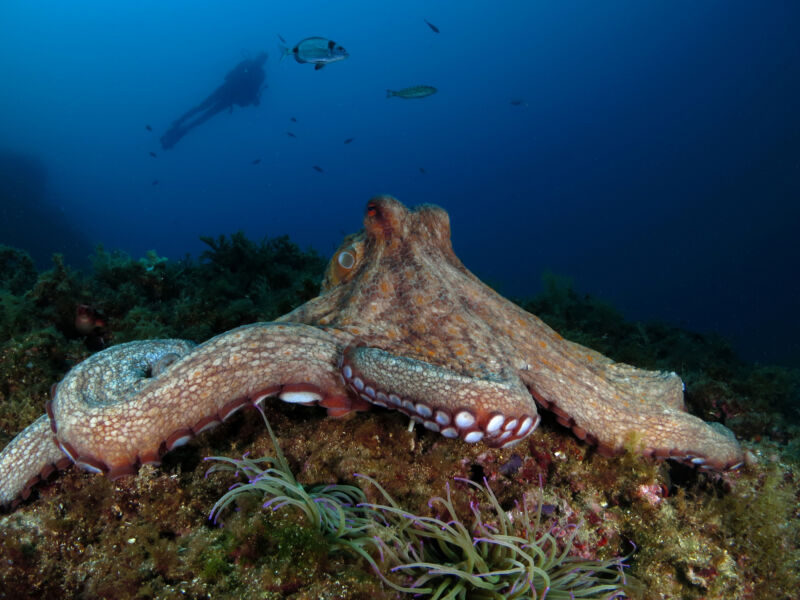
Most creatures sleep, but until now, REM (rapid eye movement) sleep, the phase of sleep in which dreams occur, was thought to be exclusive to vertebrates. Octopuses appear to be the first invertebrates to show they are also capable of this
When it comes to neural function, studies have found these cephalopods are more like us than we think (pun somewhat intended). Having no spine hasn’t stopped them from evolving a complex nervous system. A 2022 study found that parts of their brains, the frontal and vertical lobes, work much like the hippocampus and limbic lobe in humans and other vertebrates. The hippocampus is critical to learning and memory, while the limbic lobe controls complex emotional reactions, such as the fight-or-flight response that is triggered by stress or fear.
Now it seems that octopuses have even more in common with us. In studying their sleep behavior, a team of researchers at the Okinawa Institute of Science and Technology observed both periods of quiet sleep, or NREM sleep (also known as slow wave sleep), and bursts of neural activity, during which the animals’ eyes and tentacles twitched while their skin changed color. Neural activities like these, which are similar to the waking state, only happen during REM sleep. Because they can transition between NREM and REM sleep, octopuses are the only known invertebrates that have two phases of sleep.
“If the functions ascribed to two-stage sleep are truly general, then one may expect to find neural and behavioral correlates of two-stage sleep widely among animals showing complex cognitive abilities,” the research team, led by neuroethologist Sam Reiter of the University of Okinawa, wrote in a recent study.
You awake?
To pursue this study, Reiter’s team needed to check that the octopuses were, in fact, asleep. They waited until the animals appeared asleep. When their eight-legged subjects were lying flat on the bottoms of the tanks, the team stimulated them to see if there would be a delayed reaction. The octopuses’ reaction to this stimulation was much slower than when they were awake. When the team was positive that the animals were asleep, they began observations.
They used local field potential (LFP) recording to observe activity in the brains of the sleeping octopuses. LFP, which tracks the electric potential surrounding neurons, is an electrophysiological method that can pick up on signals from cognitive processes. For LFP recording, the team relied on probes inserted into the animals’ brains. (A microscope was later used to confirm precisely what parts of the brain these probes were listening in on.) They also watched for visible changes in behavior on the outside.
During NREM sleep, little activity was detected in the octopuses’ brains, and any behavioral changes were extremely subtle. There was one fascinating thing that surfaced during this phase. A certain pattern of brain waves known as a “sleep spindle,” which also occurs during human NREM sleep, was detected. What exactly a sleep spindle does is not completely known yet, though this wave pattern is thought to be associated with memory.
However, about once an hour, everything changed when REM sleep set in. LFP recordings showed a remarkable increase in activity in the frontal and vertical lobes, the same regions that were previously found to have similar activities to those of the human brain. It turned out LFP recordings made during octopus REM sleep were extremely close to those done during a waking state. It was during this phase of sleep that the researchers saw the skin of the cephalopods change colors.
Shifting pigments
Octopus color change happens at the cellular level. The cells that contain pigment are chromatophores. The pigment sacs in these cells contain mostly brown, black, red, and yellow pigments. When the muscles around each chromatophore loosen, the pigment sacs expand, making more pigment visible, while less can be seen when the muscles tighten and the sacs contract. The scientists think that it is possible the octopuses they monitored could have been mentally practicing using this system for camouflage based on their memories; if that is what they were doing, they might be able to dream.
“[REM sleep] skin patterns operate under direct neural control, thus providing a unique window into the contents of neural activity in the offline brain,” the research team also said in the study.
Reiter wants to continue investigating the sleeping octopus brain and is especially interested in figuring out whether the color changes during REM sleep really are indicative of dreams. Do they really dream? Not bad for an invertebrate that has been around for 550 million years.
Nature, 2023. DOI: 10.1038/s41586-023-06203-4 (About DOIs).
Elizabeth Rayne is a creature who writes. Her work has appeared on SYFY WIRE, Space.com, Live Science, Grunge, Den of Geek, and Forbidden Futures. When not writing, she is either shapeshifting, drawing, or cosplaying as a character nobody ever heard of. Follow her on Twitter @quothravenrayne.
https://arstechnica.com/?p=1951910

